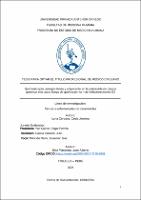Quimioterapia perioperatoria y adyuvante en la sobrevida de cáncer gástrico avanzado luego de gastrectomía más linfadenectomía D2
Abstract
Objetivo: Comparar la efectividad de la quimioterapia perioperatoria con la
quimioterapia adyuvante en la sobrevida de pacientes con cáncer gástrico luego
de gastrectomía con linfadenectomía D2 (T2-T4a)
Materiales y Métodos: Se realizó un estudio observacional, de cohortes
retrospectivas, se tomó una población censal que hayan recibido quimioterapia
perioperatoria o adyuvante en un instituto oncológico peruano entre el 1° de
enero del 2007 al 31 de diciembre del 2022. Para determinar la sobrevida
actuarial se usará el método de Kaplan-Meier y el test de log-rank para
comparación de 2 curvas de supervivencia. Se considerará un valor p<0.05%
como estadísticamente significativo.
Resultados: Se evaluó una población total de 82 pacientes, de los cuales 46
recibieron quimioterapia adyuvante y 36 quimioterapia perioperatoria siendo el
esquema más usado el CAPOX y EOX/EOX, respectivamente. Las
características clínicas no influyeron significativamente en la sobrevida general
y solo el tumor primario (T) tuvo una asociación estadísticamente significativa,
siendo el T4a más frecuente en el grupo de quimioterapia perioperatoria que en
el de modalidad adyuvante (80.6% vs 47.8%; p=0.002). Al comparar ambas
modalidades terapéuticas se evidenció que los pacientes que recibieron la
quimioterapia perioperatoria presentaron una mayor sobrevida a los 5 años
(53,2%), sin embargo, esto no fue estadísticamente significativo (p=0.230).
Conclusiones: La quimioterapia perioperatoria presentó mayor sobrevida en
comparación a la quimioterapia adyuvante a los 12, 36 y 60 a meses; Sin
embargo, estas diferencias no fueron estadísticamente significativas Objective: To compare the effectiveness of perioperative chemotherapy with
adjuvant chemotherapy in the survival of patients with gastric cancer after
gastrectomy with D2 lymphadenectomy (T2-T4a).
Materials and Methods: An observational, retrospective cohort study was
performed on a census population matched by age and tumor location who had
received perioperative or adjuvant chemotherapy in a Peruvian oncology institute
between January 1, 2007 and December 31, 2022. To determine actuarial
survival, the Kaplan-Meier method and the log-rank test for comparison of 2
survival curves will be used. A p value <0.05% will be considered statistically
significant.
Results: A total population of 82 patients was evaluated, of which 46 received
adjuvant chemotherapy and 36 received perioperative chemotherapy, with
CAPOX and EOX/EOX being the most commonly used regimens, respectively.
Clinical characteristics did not significantly influence overall survival and only the
primary tumor (T) had a statistically significant association, with T4a being more
frequent in the perioperative chemotherapy group than in the adjuvant modality
(80.6% vs 47.8%; p=0.002). When comparing both therapeutic modalities, it was
evidenced that patients who received perioperative chemotherapy presented
greater survival at 5 years (53.2%), however, this was not statistically significant
(p=0.230).
Conclusions: Perioperative chemotherapy presented greater survival
compared to adjuvant chemotherapy at 12, 36 and 60 months; however, these
differences were not statistically significant
Collections
- Medicina Humana [2969]


